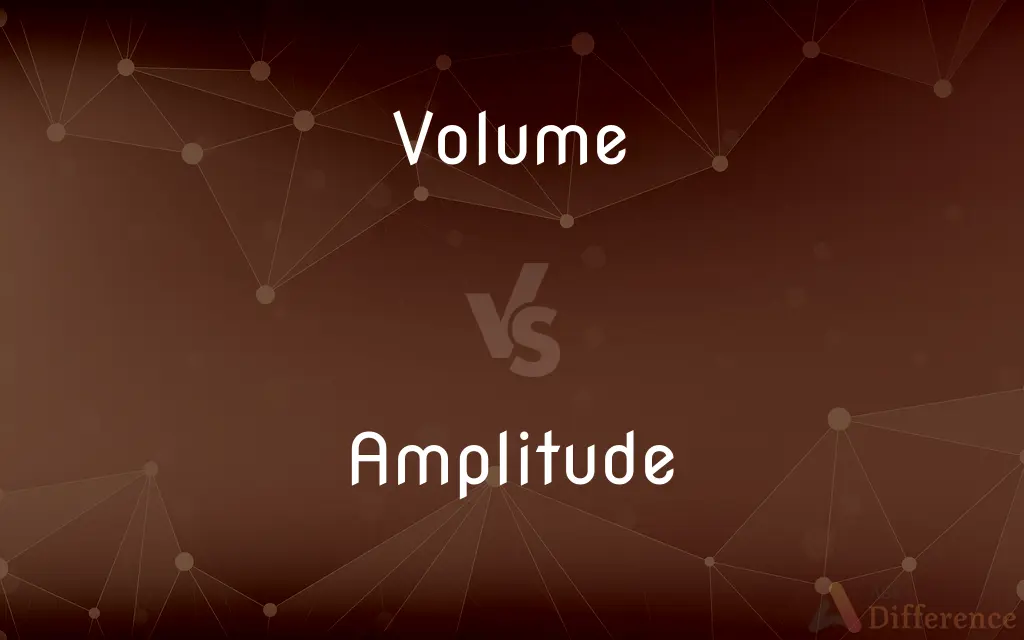Volume vs. Amplitude — What's the Difference?
By Fiza Rafique & Urooj Arif — Updated on March 15, 2024
Volume refers to the loudness or intensity of a sound as perceived by the ear, while amplitude is the height of a wave's peak, affecting sound's loudness.

Difference Between Volume and Amplitude
Table of Contents
ADVERTISEMENT
Key Differences
Volume is a subjective measure describing how loud or soft a sound appears to a listener. It's influenced by the environment and the listener's hearing abilities. Whereas amplitude is a physical attribute of a sound wave, specifically its peak value, which directly impacts the sound's volume. High amplitude corresponds to loud sounds, and low amplitude to soft sounds.
Volume is often adjusted by the listener through devices like speakers or headphones to suit personal preferences or environmental needs. On the other hand, amplitude is a fixed characteristic of a sound wave that can be measured objectively using instruments but not directly altered by listeners.
In music and audio engineering, volume adjustments are crucial for balancing the sound mix and ensuring a pleasant listening experience. Conversely, understanding and measuring amplitude is essential for sound engineers to manipulate recordings and live sounds accurately.
While volume is perceived differently by each individual, amplitude provides a consistent basis for quantifying sound levels. This distinction makes amplitude a key factor in setting standards for sound production and broadcasting.
Volume controls are ubiquitous in consumer audio devices, allowing users to easily adjust the loudness of sound. Amplitude, however, is typically adjusted at the source or during the sound production process to achieve the desired volume.
ADVERTISEMENT
Comparison Chart
Definition
The perceived loudness of sound
The height of a sound wave's peak
Measurement
Subjective, varies with listener
Objective, measurable with instruments
Control
Adjusted by listeners through devices
Fixed, determined by the sound source
Role in Audio
Adjusted for comfort or environmental needs
Determines loudness, adjusted in production
Perception/Utility
Varies by individual, influenced by environment
Consistent, used for sound level standards
Compare with Definitions
Volume
The loudness of sound as perceived by the ear.
The volume of the concert was too high for some audience members.
Amplitude
The maximum extent of a vibration or oscillation, measured from the position of equilibrium.
The amplitude of the sound wave determines how loud it will sound.
Volume
The amount of space a substance or object occupies.
(Not applicable in this context but included for clarity.)
Amplitude
The magnitude of change in a fluctuating variable.
The amplitude of temperature changes varies throughout the year.
Volume
A control setting on electronic devices to adjust sound loudness.
She turned down the volume on her TV to avoid disturbing her neighbors.
Amplitude
The height of a wave's peak.
Seismic waves have amplitudes that scientists measure to understand earthquakes.
Volume
In literature, a book forming part of a work or series.
(Not applicable in this context but included for clarity.)
Amplitude
In physics, the maximum displacement of points on a wave.
A higher amplitude means the wave carries more energy.
Volume
The degree of sound intensity.
The volume of his voice increased as he became more excited.
Amplitude
A measure of the strength of a signal.
The amplitude of the radio signal weakens with distance.
Volume
Volume is the quantity of three-dimensional space enclosed by a closed surface, for example, the space that a substance (solid, liquid, gas, or plasma) or 3D shape occupies or contains. Volume is often quantified numerically using the SI derived unit, the cubic metre.
Amplitude
The amplitude of a periodic variable is a measure of its change in a single period (such as time or spatial period). There are various definitions of amplitude (see below), which are all functions of the magnitude of the differences between the variable's extreme values.
Volume
A collection of written or printed sheets bound together; a book.
Amplitude
Greatness of size; magnitude.
Volume
One of the books of a work printed and bound in more than one book.
Amplitude
Fullness; copiousness.
Volume
A series of issues of a periodical, usually covering one calendar year.
Amplitude
Breadth or range, as of intelligence.
Volume
A unit of written material assembled together and cataloged in a library.
Amplitude
(Astronomy) The angular distance along the horizon from true east or west to the intersection of the vertical circle of a celestial body with the horizon.
Volume
A roll of parchment; a scroll.
Amplitude
(Physics) The maximum absolute value of a periodically varying quantity.
Volume
The amount of space occupied by a three-dimensional object or region of space, expressed in cubic units.
Amplitude
The maximum absolute value of a periodic curve measured along its vertical axis.
Volume
The capacity of such a region or of a specified container, expressed in cubic units.
Amplitude
The angle made with the positive horizontal axis by the vector representation of a complex number.
Volume
Amount; quantity:a low volume of business; a considerable volume of lumber.
Amplitude
(Electronics) The maximum absolute value reached by a voltage or current waveform.
Volume
OftenvolumesA large amount:volumes of praise.
Amplitude
The measure of something's size, especially in terms of width or breadth; largeness, magnitude.
Volume
The amplitude or loudness of a sound.
Amplitude
(mathematics) The maximum absolute value of the vertical component of a curve or function, especially one that is periodic.
Volume
A control, as on a radio, for adjusting amplitude or loudness.
Amplitude
(physics) The maximum absolute value of some quantity that varies.
Volume
A three-dimensional measure of space that comprises a length, a width and a height. It is measured in units of cubic centimeters in metric, cubic inches or cubic feet in English measurement.
The room is 9x12x8, so its volume is 864 cubic feet.
The proper products can improve your hair's volume.
Amplitude
(astronomy) The arc of the horizon between the true east or west point and the center of the sun, or a star, at its rising or setting. At the rising, the amplitude is eastern or ortive: at the setting, it is western, occiduous, or occasive. It is also northern or southern, when north or south of the equator.
Volume
Strength of sound; loudness.
Please turn down the volume on the stereo.
Volume can be measured in decibels.
Amplitude
(astronomy) The arc of the horizon between the true east or west point and the foot of the vertical circle passing through any star or object.
Volume
The issues of a periodical over a period of one year.
I looked at this week's copy of the magazine. It was volume 23, issue 45.
Amplitude
(firearms) The horizontal line which measures the distance to which a projectile is thrown; the range.
Volume
A bound book.
Amplitude
State of being ample; extent of surface or space; largeness of dimensions; size.
The cathedral of Lincoln . . . is a magnificent structure, proportionable to the amplitude of the diocese.
Volume
A single book of a publication issued in multi-book format, such as an encyclopedia.
The letter "G" was found in volume 4.
Amplitude
Largeness, in a figurative sense; breadth; abundance; fullness.
Volume
A great amount (of meaning) about something.
Amplitude
The arc of the horizon between the true east or west point and the center of the sun, or a star, at its rising or setting. At the rising, the amplitude is eastern or ortive: at the setting, it is western, occiduous, or occasive. It is also northern or southern, when north or south of the equator.
Volume
(obsolete) A roll or scroll, which was the form of ancient books.
Amplitude
The horizontal line which measures the distance to which a projectile is thrown; the range.
Volume
Quantity.
The volume of ticket sales decreased this week.
Amplitude
The extent of a movement measured from the starting point or position of equilibrium; - applied especially to vibratory movements.
Volume
A rounded mass or convolution.
Amplitude
An angle upon which the value of some function depends; - a term used more especially in connection with elliptic functions.
Volume
(economics) The total supply of money in circulation or, less frequently, total amount of credit extended, within a specified national market or worldwide.
Amplitude
(physics) the maximum displacement of a periodic wave
Volume
(computing) An accessible storage area with a single file system, typically resident on a single partition of a hard disk.
Amplitude
The property of copious abundance
Volume
(bodybuilding) The total of weight worked by a muscle in one training session, the weight of every single repetition summed up.
Amplitude
Greatness of magnitude
Volume
(intransitive) To be conveyed through the air, waft.
Volume
(transitive) To cause to move through the air, waft.
Volume
(intransitive) To swell.
Volume
A roll; a scroll; a written document rolled up for keeping or for use, after the manner of the ancients.
The papyrus, and afterward the parchment, was joined together [by the ancients] to form one sheet, and then rolled upon a staff into a volume (volumen).
Volume
Hence, a collection of printed sheets bound together, whether containing a single work, or a part of a work, or more than one work; a book; a tome; especially, that part of an extended work which is bound up together in one cover; as, a work in four volumes.
An odd volume of a set of books bears not the value of its proportion to the set.
Volume
Anything of a rounded or swelling form resembling a roll; a turn; a convolution; a coil.
So glides some trodden serpent on the grass,And long behind wounded volume trails.
Undulating billows rolling their silver volumes.
Volume
Dimensions; compass; space occupied, as measured by cubic units, that is, cubic inches, feet, yards, etc.; mass; bulk; as, the volume of an elephant's body; a volume of gas.
Volume
Amount, fullness, quantity, or caliber of voice or tone.
Volume
The amount of 3-dimensional space occupied by an object;
The gas expanded to twice its original volume
Volume
The property of something that is great in magnitude;
It is cheaper to buy it in bulk
He received a mass of correspondence
The volume of exports
Volume
Physical objects consisting of a number of pages bound together;
He used a large book as a doorstop
Volume
A publication that is one of a set of several similar publications;
The third volume was missing
He asked for the 1989 volume of the Annual Review
Volume
A relative amount;
Mix one volume of the solution with ten volumes of water
Volume
The magnitude of sound (usually in a specified direction);
The kids played their music at full volume
Common Curiosities
How does volume differ from amplitude?
Volume is subjective and perceived, while amplitude is a physical, measurable attribute of a sound wave.
What is volume?
Volume is the perceived loudness of sound to the human ear.
How is amplitude measured?
Amplitude is measured using instruments that gauge the height of sound waves.
What is amplitude?
Amplitude is the height of a sound wave's peak, indicating its strength.
Can two sounds have the same amplitude but different volumes?
Yes, due to factors like frequency and the listener's hearing, perceived volume can differ.
What role does environment play in volume perception?
Environmental factors can influence how we perceive volume, making sounds seem louder or softer.
Can amplitude affect volume?
Yes, higher amplitudes result in louder volumes.
How do volume controls work on devices?
Volume controls adjust the output power to speakers, affecting the sound's loudness.
Is volume adjustable by the listener?
Yes, listeners can adjust volume through various devices.
Why is understanding amplitude important in audio production?
Amplitude influences the loudness of sounds, essential for sound mixing and production.
Do all audio devices have volume controls?
Most audio devices feature volume controls for user adjustment.
Why might two people perceive the volume of the same sound differently?
Individual hearing abilities and environmental conditions can lead to different volume perceptions.
What is the relationship between amplitude and energy?
Higher amplitudes mean more energy in the wave, leading to louder sounds.
What does a high amplitude indicate about a sound?
High amplitude indicates a loud sound with high energy levels.
Can volume be measured objectively?
While perceived volume is subjective, sound intensity levels can be measured in decibels.
Share Your Discovery

Previous Comparison
Arian vs. Aryan
Next Comparison
Beyoncé vs. RihannaAuthor Spotlight
Written by
Fiza RafiqueFiza Rafique is a skilled content writer at AskDifference.com, where she meticulously refines and enhances written pieces. Drawing from her vast editorial expertise, Fiza ensures clarity, accuracy, and precision in every article. Passionate about language, she continually seeks to elevate the quality of content for readers worldwide.
Co-written by
Urooj ArifUrooj is a skilled content writer at Ask Difference, known for her exceptional ability to simplify complex topics into engaging and informative content. With a passion for research and a flair for clear, concise writing, she consistently delivers articles that resonate with our diverse audience.
















































